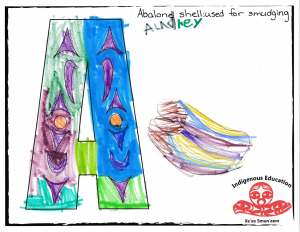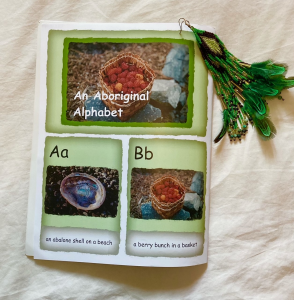13 An Aboriginal Alphabet
Neeve Mathews
Contributor’s Biography:
Neeve Mathews is a third-year student at Kwantlen Polytechnic University. They aspire to be an elementary school teacher once they complete a Bachelor of Education. Neeve enjoys dancing, playing and watching sports.
Resource Overview
Book:
Holloway, P. (2013). An Aboriginal alphabet. Cedar Moon Creations.
Grade Level: Kindergarten to grade one
Description:
The book An Aboriginal Alphabet by Pam Holloway from Kwakwaka’wakw First Nation includes captioned Indigenous-themed photographs centred around each letter of the English alphabet. The book alphabetically highlights important people, places, objects, and significant events in various Indigenous communities. For example, the letter “A” would match with a photograph of an abalone shell (Holloway, 2013).
Significant Indigenous Knowledge:
Teaching the alphabet through an Indigenous lens as opposed to a Westernized lens offers participants a different perspective. The First Peoples Principles highlights: “…the understanding that Indigenous Peoples hold an extensive wealth of knowledge, even if this knowledge has not always been recognized by Euro-centric cultures. It also recognizes that Indigenous Knowledges contributes to the non-Indigenous understandings in the world” (Chrona, 2016, para, 1). The book, An Aboriginal Alphabet, offers Indigenous voices while teaching core curricular competencies at kindergarten and grade one levels. It offers participants a broader perception of literacy and demonstrates the value found in various knowledge systems (Chrona, 2016). The resource also facilitates relationship building with Indigenous participants and non-Indigenous participants in the classroom since it promotes inclusivity and mutual respect. It also provides an opportunity for Indigenous participants to deepen their cultural understanding, “the First Nations children of today must know their past, their true history, to understand the present and plan for the future” (Maina, 1997, p. 294). The use of An Aboriginal Alphabet in the classroom can help participants create bridges to new understandings and learn more about themselves.
Necessary Prior Knowledge:
Before using this resource, it is recommended that the educator becomes familiar with each item presented within the alphabet and their respective significance to First Nations communities. For instance, even though it is not explicitly stated in the book, the educator should know that the berries depicted are salmonberries. They must understand salmonberries’ holistic and practical uses as well. Within the book there is also: an abalone shell, a berry bunch, a canoe, a drum with an Indigenous design on it, an eagle, a feather, a grizzly bear painting, a cedar weaved hat, Vancouver Island on a map, silver carved jewellery, a kingfisher bird, ladies dressed in button blankets, a mask, a silver carved necklace, an oyster shell, a paddle, a qulus mask, a raven, a salmon, a totem pole, an umbrella, a vase, a whale, an extra big Indigenous house, a yellow skunk cabbage plant, a weaved zig zag pattern on a mat. The educator should research the cultural and historical significance connected to each item represented in the book. For example, they would need to understand that the animals featured have spiritual significance. It is crucial to have guidance from local Indigenous Peoples while teaching Indigenous content so that it is not misunderstood by those who lack experience with Indigenous Knowledges systems (Kerr & Parent, 2018).
*Note from the editors: if you are unable to access the resource An Aboriginal Alphabet by Pam Holloway, below we have provided web links to alternative Indigenous-inspired alphabets.
Suggested Learning Activities
One possible activity used to facilitate An Aboriginal Alphabet could be to create an alphabet puzzle. The participants would match Indigenous-inspired images found within the book to the corresponding letters. For example, the card that states “E is for eagle in a tree” (Holloway, 2013, p.2) would pair with the letter E card. As the puzzle contains 52 different components (26 letters cards and 26 Aboriginal-inspired images) participants would be encouraged to complete this activity in groups.
As a second activity, the educator could go to the following website, where they will find the letters of the alphabet adorned by Coast Salish designs. Each participant would receive a printed piece of paper from the website with the first letter of their name. Participants would then colour the Coast Salish inspired letter. Once participants finished colouring the letter, they would draw the item that is associated with the letter of their name, from An Aboriginal Alphabet.


Image by: Rachel Chong BY-NC-ND (Attribution Non-Commercial No Derivatives)
References
Chrona, J. (2016). Learning recognizes the role of Indigenous knowledge. https://firstpeoplesprinciplesoflearning.wordpress.com/learning- recognizes-the-role-of-indigenous-knowledge/
First Nations Education Steering Committee. (2013). Authentic First Peoples resources. https://resources.fnesc.ca/CatalogItems/Details/4
First Nations Education Steering Committee. (2016). Authentic First Peoples resources, K-9. http://www.fnesc.ca/wp/wp-content/uploads/2015/06/PUBLICATION-61502-updated-FNESC-Authentic-Resources-Guide-October-2016.pdf
Holloway, P. (2013). An Aboriginal alphabet. Cedar Moon Creations.
Kerr, J. & Parent, A. (2018) The First Peoples principles’ of learning in teacher education: Responding to the Truth and Reconciliation Commission’s Calls to Action. Canadian Journal of Native Education. 40 (1), pp 36-53.
Maina, F. (1997). Culturally relevant pedagogy First Nations education in Canada. First Nations Education in Canada, (2), 293-314. http://www3.brandonu.ca/cjns/17.2/cjnsv17no2_pg293-314.pdf

